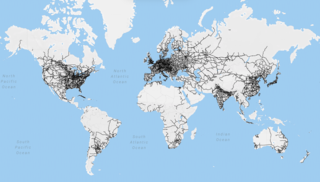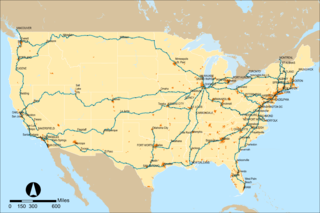This article needs additional citations for verification .(November 2015) (Learn how and when to remove this template message) |
Charles Peck (1873 - 1941) was a British racehorse trainer. He was Champion Trainer in 1915. [1]
This article needs additional citations for verification .(November 2015) (Learn how and when to remove this template message) |
Charles Peck (1873 - 1941) was a British racehorse trainer. He was Champion Trainer in 1915. [1]

The Channel Tunnel (French: Le tunnel sous la Manche), also referred to as the Eurotunnel or Chunnel, is a 50.45-kilometre (31.35 mi) railway tunnel that connects Folkestone with Coquelles beneath the English Channel at the Strait of Dover. It is the only fixed link between the island of Great Britain and the European mainland. At its lowest point, it is 75 m (250 ft) deep below the sea bed and 115 m (380 ft) below sea level. At 37.9 kilometres (23.5 mi), the tunnel has the longest underwater section of any tunnel in the world, and is the third longest railway tunnel in the world. The speed limit for trains through the tunnel is 160 km/h (100 mph).

The Canadian Pacific Railway (CPR), known as CP Rail between 1968 and 1996 and simply Canadian Pacific, is a historic Canadian Class I railway incorporated in 1881. The railway is owned by Canadian Pacific Railway Limited, which began operations as legal owner in a corporate restructuring in 2001.

Rail transport is a means of transferring passengers and goods on wheeled vehicles running on rails, which are located on tracks. In contrast to road transport, where the vehicles run on a prepared flat surface, rail vehicles are directionally guided by the tracks on which they run. Tracks usually consist of steel rails, installed on sleepers (ties) set in ballast, on which the rolling stock, usually fitted with metal wheels, moves. Other variations are also possible, such as "slab track", in which the rails are fastened to a concrete foundation resting on a prepared subsurface.

The National Railroad Passenger Corporation, doing business as Amtrak, is a passenger railroad service that provides medium and long-distance intercity service in the contiguous United States and to nine Canadian cities.

The Bakerloo line is a London Underground line that runs between Harrow & Wealdstone in suburban north-west London and Elephant & Castle in south London, via the West End. Coloured brown on the Tube map, it serves 25 stations, 15 of which are below ground, over 14.4 miles (23.2 km). It runs partly on the surface and partly in deep-level tube tunnels.

The Northern line is a London Underground line that runs from south-west to north-west London, with two branches through central London and three in north London. It runs northwards from its southern terminus at Morden in the borough of Merton to Kennington in Southwark, where it divides into two central branches, one via Charing Cross in the West End and the other via Bank in the City. The central branches re-join at Camden Town where the line again divides into two branches, one to High Barnet and the other to Edgware in the borough of Barnet. The High Barnet branch has an additional single-station spur at Finchley Central with a shuttle train to Mill Hill East.

The Piccadilly line is a deep level London Underground line running from the north to the west of London. It has two branches, which split at Acton Town, and serves 53 stations. The line is known for serving Heathrow Airport, and is near popular attractions such as Buckingham Palace. The District and Metropolitan lines share some sections of tracks with the Piccadilly line. Coloured dark blue on the Tube map, it is the fourth-busiest line on the Underground network with over 210 million passenger journeys in 2011/12.

The Great Western Railway (GWR) was a British railway company that linked London with the southwest and west of England, the West Midlands, and most of Wales. It was founded in 1833, received its enabling Act of Parliament on 31 August 1835 and ran its first trains in 1838. It was engineered by Isambard Kingdom Brunel, who chose a broad gauge of 7 ft —later slightly widened to 7 ft 1⁄4 in —but, from 1854, a series of amalgamations saw it also operate 4 ft 8 1⁄2 in standard-gauge trains; the last broad-gauge services were operated in 1892.

The Great Central Railway in England came into being when the Manchester, Sheffield and Lincolnshire Railway changed its name in 1897, anticipating the opening in 1899 of its London Extension. On 1 January 1923, the company was grouped into the London and North Eastern Railway.

The London and North Western Railway was a British railway company between 1846 and 1922. In the late 19th century, the L&NWR was the largest joint stock company in the United Kingdom.

The London, Midland and Scottish Railway (LMS) was a British railway company. It was formed on 1 January 1923 under the Railways Act of 1921, which required the grouping of over 120 separate railways into four. The companies merged into the LMS included the London and North Western Railway, Midland Railway, the Lancashire and Yorkshire Railway, several Scottish railway companies, and numerous other, smaller ventures.

The Midland Railway (MR) was a railway company in the United Kingdom from 1844. The Midland was one of the largest railway companies in Britain in the early 20th century, and the largest employer in Derby, where it had its headquarters. It amalgamated with several other railways to create the London, Midland and Scottish Railway at grouping in 1922.

The London and North Eastern Railway (LNER) was the second largest of the "Big Four" railway companies created by the Railways Act 1921 in Britain. It operated from 1 January 1923 until nationalisation on 1 January 1948. At that time, it was divided into the new British Railways' Eastern Region, North Eastern Region, and partially the Scottish Region.

The Southern Pacific was an American Class I railroad network that existed from 1865 to 1996 and operated largely in the Western United States. The system was operated by various companies under the names Southern Pacific Railroad, Southern Pacific Company and Southern Pacific Transportation Company.

The Whyte notation is a classification method for steam locomotives, and some internal combustion locomotives and electric locomotives, by wheel arrangement. It was devised by Frederick Methvan Whyte, and came into use in the early twentieth century following a December 1900 editorial in American Engineer and Railroad Journal.

Indian Railways(IR) is a governmental entity under the Ministry of Railways that operates India's national railway system. It is run by the government as a government entity and manages the fourth-largest railway network in the world by size, with a route length of 67,956 km (42,226 mi) as of 31 March 2020. 39,866 km (24,772 mi) or 58.66% of all the routes are electrified with 25 kV 50 Hz AC electric traction as of August 2020.

A railfan, rail buff or train buff ; railway enthusiast or railway buff ; trainspotter or ferroequinologist, is a person interested, recreationally, in rail transport.

Rapid transit or mass rapid transit (MRT), also known as heavy rail, metro, subway, tube, U-Bahn, metropolitana or underground, is a type of high-capacity public transport generally found in urban areas. Unlike buses or trams, rapid transit systems are electric railways that operate on an exclusive right-of-way, which cannot be accessed by pedestrians or other vehicles of any sort, and which is often grade-separated in tunnels or on elevated railways.

On 23 March 2020, the Government of India under Prime Minister Narendra Modi ordered a nationwide lockdown for 21 days, limiting movement of the entire 1.38 billion or 138 Crore population of India as a preventive measure against the COVID-19 pandemic in India. It was ordered after a 14-hour voluntary public curfew on 22 March, followed by enforcement of a series of regulations in the country's COVID-19 affected regions. The lockdown was placed when the number of confirmed positive coronavirus cases in India was approximately 500. Observers stated that the lockdown had slowed the growth rate of the pandemic by 6 April to a rate of doubling every six days, and by 18 April, to a rate of doubling every eight days. As the end of the first lockdown period approached, state governments and other advisory committees recommended extending the lockdown. The governments of Odisha and Punjab extended the state lockdowns to 1 May. Maharashtra, Karnataka, West Bengal and Telangana followed suit. On 14 April, Prime minister Narendra Modi extended the nationwide lockdown until 3 May, with a conditional relaxations after 20 April for the regions where the spread had been contained or was minimal.